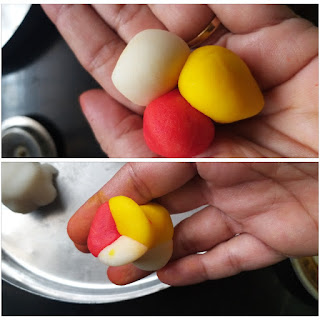Ganesh Chaturthi [also known as Vinayaka Chaturthi] is the
Hindu festival celebrated in honur of the elephant-headed god, Lord Ganesha.
This is very auspicious day celebrated to pray the god so that every new
activity that is started is successfully completed without any obstacles. As
with all festivals, hymns are sung, prayers are recited and prasad [offering in
the form of food] is made. Legend has it that Modak are Lord Ganesha’s
favourite sweet and are thus made by devotees to offer to him as prasad.
Traditionally Mahrashtrian households prepare these modaks by making a rice
flour dough and then filling it with freshly scraped and grated coconut-jaggery
stuffing. Sweet shops across the length and breadth of the country are flooded
with modaks of every size, flavour and colour, but traditional steamed ones are
hard to find at retail shops and they are the best. Maharashtrian Modak recipe
popularly known as Ukadiche Modak in my try list for long time. Last year I
tried , but the plain ones, so this year plan to make the colourful ones. I was
very curious about the colourful pari/ cover, so watched so many videos on You
Tube which helped me lot to solve all my doubts and to make a good modak recipe.
Apart from shaping the modak, I didn’t
feel anything difficult in this recipe. I must admit here that the outer
covering/ pari needs some practice. But I really want to try and love this
ukadiche modak, so tried them with the mould. Though I have used a modak mould,
you don’t need compulsorily one. A little practice and you can easily make them
by hand as the dough is filled, pulled, twisted and shaped exactly like one
would a momo.
INGREDIENTS:
For Outer Cover:
1 Cup Rice Flour
1 Cup Water
Salt to taste
½ teaspoon Ghee
For Stuffing:
½ Cup Jaggery
1 Cup Fresh grated Coconut
¼ teaspoon Cardamom Powder
1 teaspoon Poppy Seeds
Other Ingredients:
Yellow and Red Food Colour
1 teaspoon Ghee
METHOD:
For Making Outer Cover:
STEP 1 – In a vessel, add water, salt and ghee and bring it
to boil.
STEP 2 – When water begins to boil, add rice flour and mix
it.
STEP 3 – Turn off the gas and cover it for 10 minutes.
For Making Stuffing:
STEP 1 – Heat up a pan on medium flame, add poppy seeds and
dry roast it for 1 minute.
STEP 2 – Then add grated coconut, roast it for about 2
minutes.
STEP 3 – Add grated jaggery and mix well.
STEP 4 – Fry for about 5-7 minutes until the mixture becomes
a little dry.
STEP 5 – Turn off the gas and add cardamom powder and mix
it.
STEP 6 – Let the mixture cool down to room temperature and
stuffing is ready.
How to proceed:
STEP 1 – Take the ukad/ rice mixture into a big dish/ bowl
and knead it really well for approximately 7-8 minutes.
STEP 2 – If you feel ukad is getting dry and unable to knead,
then you can use a little ghee or hot water for kneading.
STEP 3 – Divide the ukad in equal 3 portions [depends upon
how many colours you are going to use].
STEP 4 – Add a drop of red colour in one dough portion and
mix well. Keep it covered.
STEP 5 – In another portion, add a drop of yellow colour and
knead it again.
STEP 6 – Now we have 3 coloured dough balls of equal size.
STEP 7 – Divide each of them in equal small portions, like
red, yellow and white. Cover the dough with wet cloth.
STEP 8 – Now take 1 ball from each colored portion and
press them together as shown in the picture below. It should be properly sealed
and there should be no gap left.
STEP 9 – If it is sticking to your hand while making pari or
modak, then use some rice flour while making pari. I have used modak mould as I
am not expert in making modak with pari. Grease the mould with ghee.
STEP 10 – Put the mixed colored dough ball in a greased
modak mould and press well. Keep the gap to fill with stuffing.
STEP 11 – Fill the gap with the stuffing and seal it from
the bottom with some dough.
STEP 12 – Heat a
steamer with water in it. Grease a banana leaf with some ghee and keep it
aside.
STEP 13 - Likewise prepare all the modaks and keep aside.
STEP 14 – Once all the modaks are done, place the modak onto
a steamer plate, which have been lined with banana leaf or muslin cloth. [I
used idli steamer and a colander to steam my modak]
STEP 15 – Steam the modak for 15-20 minutes on a medium
flame.
STEP 16 – Pour in some ghee onto the steaming hot modak and
they are ready to be served.

















































